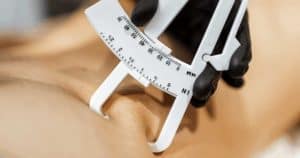
Body Mass Index is used commonly while calculating body fat and for fitness level assessments, but what does it really mean? Body Mass Index, or BMI, is a measurement that uses an individual’s current height and weight to determine their body fat using a simple equation. This equation is as follows:
BMI=weight(lb) * 703 / height2 (in2)
or
BMI (metric)=weight(kg) / height2 (m2)
The number resulting from this equation is essentially your body fat percentage. Healthy body fat percentage differs between men and women, below is a chart with each gender’s ranges:
Women’s BMI Chart:
| Age | Underfat | Healthy Range | Overweight | Obese |
| 20-40yrs | Under 21% | 21-33% | 33-39% | Over 39% |
| 41-60yrs | Under 23% | 23-35% | 35-40% | Over 40% |
| 61-79yrs | Under 24% | 24-36% | 36-42% | Over 42% |
Men’s BMI Chart:
| Age | Underfat | Healthy Range | Overweight | Obese |
| 20-40yrs | Under 8% | 8-19% | 19-25% | Over 25% |
| 41-60yrs | Under 11% | 11-22% | 22-27% | Over 27% |
| 61-79yrs | Under 13% | 13-25% | 25-30% | Over 30% |
Keep in mind, each individual requires body fat, and it is essential to a healthy lifestyle. If one were to drop into the “underfat” category it could interfere with normal bodily functions. Healthy and unhealthy ranges also change depending on age because individuals deposit more body fat as they grow older.
Even though the BMI calculation is fast and easy to use, it can be incorrect in certain situations. For example, if you lift weights on a regular basis, muscle weighs more than fat and therefore will cause you to be heavier. Therefore, when calculating your BMI, it is the muscle and not the fat in your body that causes you to weigh more.
BMI is a fast and easy equation for giving a rough body/fat percentage estimate, but there are other more accurate ways of measuring body fat. One of which is the “skinfold test” offered during your initial fitness assessment through the Elite Sports Clubs’ fitness centers. Contact the fitness center to make an appointment for your own polar body age and body/fat assessment.